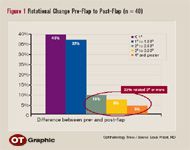Article
Iris registration ensures alignment of wavefront maps
San Francisco-A study of the repeatability and accuracy ofthe iris registration capture function in the VISX STAR excimerlaser (Advanced Medical Optics [AMO]) indicated that there islittle variability in the measurement of the rotational change andpupil centroid shift between consecutive iris registrationcaptures. There is, however, significant variability of themeasurements in different eyes. Iris registration technology allowsfor a more precise alignment and placement of wavefront treatment,Louis Probst, MD, reported at the annual meeting of the AmericanSociety of Cataract and Refractive Surgery.

"Iris registration is a nice addition to custom platforms. We know the technology works by identifying 24 iris landmarks on the WaveScan [WaveFront System] (VISX/AMO), comparing them with 24 landmarks under the laser, and then adjusting for the appropriate cyclorotation and centroid shift," Dr. Probst said. His concern, however, was with the consistency of the results.
Scans before, after flap

"We found that in the right eye preoperatively and postoperatively the average amount of cyclorotation was about 2.5°, but in some eyes there was rotation up to 6° or 7°. In the left eye, we found that there was about 3° to 3.5° of cyclorotation that ranged up to almost 8° in some cases. There was no significant difference in the two iris registration captures that were done before the flap was created and after the flap was created. It appears that the results from iris registration for rotation were reliable and consistent," he reported.
He also pointed out that no significant difference was found in the iris registration results before the flap was lifted compared with the results after the flap was lifted. "This indicates that it is O.K. to do an iris registration capture before the flap is created if the surgeon is having difficulty getting an iris registration after the flap is created."
He reported that a few outliers would have fared much better if iris registration capture had been done after the flap was created. Because of this, despite the statistical results, he urged caution on the part of surgeons.
"Most patients had only 1° to 2° of cyclorotation, but 23% of the patients had more than 2° of cyclorotation, which has been shown to be visually significant when patients have more than 1.5 D of astigmatism," he said.
In addition, 2° of cyclorotation does induce some distortion in the point spread function. "The greater the cyclorotation, the greater the distortion," he said.
Also, in patients with greater degrees of astigmatism, there is more residual astigmatism with increasing degrees of cyclorotation. "For example, the patient could have an undercorrection of 1 D of astigmatism if there was 5 D of astigmatism with only 5° of uncorrected cyclorotation," Dr. Probst explained.
Newsletter
Don’t miss out—get Ophthalmology Times updates on the latest clinical advancements and expert interviews, straight to your inbox.




